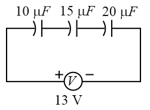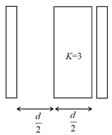MEDIUM
JEE Main
IMPORTANT
Earn 100
Two identical charged particles each having a mass and charge are placed on a horizontal table with a separation of between them such that they stay in limited equilibrium. If the coefficient of friction between each particle and the table is , find the value of . [Use ]
(a)
(b)
(c)
(d)
78.57% studentsanswered this correctly

Important Questions on Electrostatics
HARD
JEE Main
IMPORTANT
A long cylindrical volume contains a uniformly distributed charge of density . The radius of cylindrical volume is . A charge particle revolves around the cylinder in a circular path. The kinetic energy of the particle is :
MEDIUM
JEE Main
IMPORTANT
The equivalent capacitance between points and in below shown figure will be _____ .

MEDIUM
JEE Main
IMPORTANT
Two metallic plates form a parallel plate capacitor. The distance between the plate is ''. A metal sheet of thickness and of area equal to area of each plate is introduced between the plates. What will be the ratio of the new capacitance to the original capacitance of the capacitor?

MEDIUM
JEE Main
IMPORTANT
identical drops are charged at each. They combine to form a bigger drop. The potential of the bigger drop will be _____ .
EASY
JEE Main
IMPORTANT
The charge on capacitor of capacitance in the figure given below is

MEDIUM
JEE Main
IMPORTANT
A parallel plate capacitor with plate area and plate separation has a capacitance of . The new capacitance of the system if half of the space between them is filled with a dielectric material of dielectric constant (as shown in figure) will be

MEDIUM
JEE Main
IMPORTANT
Sixty four conducting drops each of radius and each carrying a charge of are combined to form a bigger drop. The ratio of surface density of bigger drop to the smaller drop will be
MEDIUM
JEE Main
IMPORTANT
Two capacitors having capacitance and respectively are connected as shown in figure. Initially, capacitor is charged to a potential difference volt by a battery. The battery is then removed and the charged capacitor is now connected to uncharged capacitor by closing the switch . The amount of charge on the capacitor , after equilibrium, is

